THE PSYCHOLOGY OF RISK PERCEPTION (c) Mikhail Slobodian

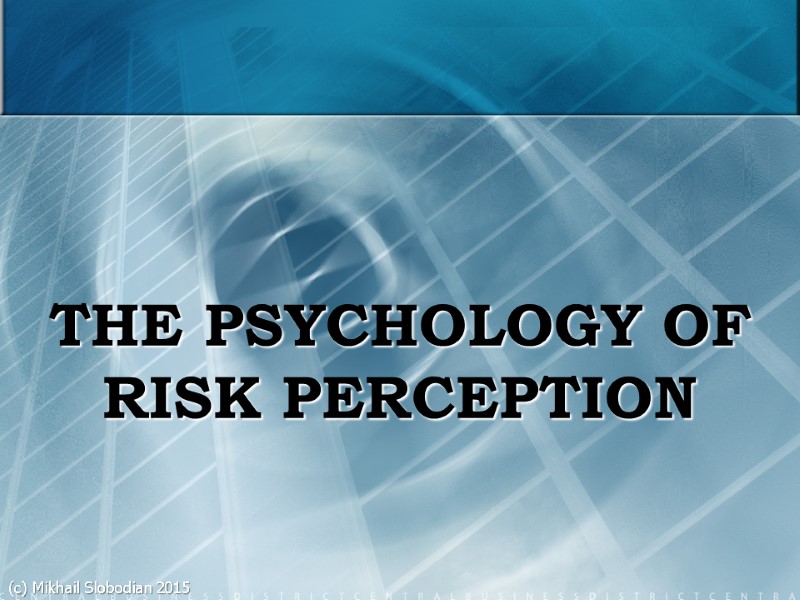
THE PSYCHOLOGY OF RISK PERCEPTION (c) Mikhail Slobodian 2015
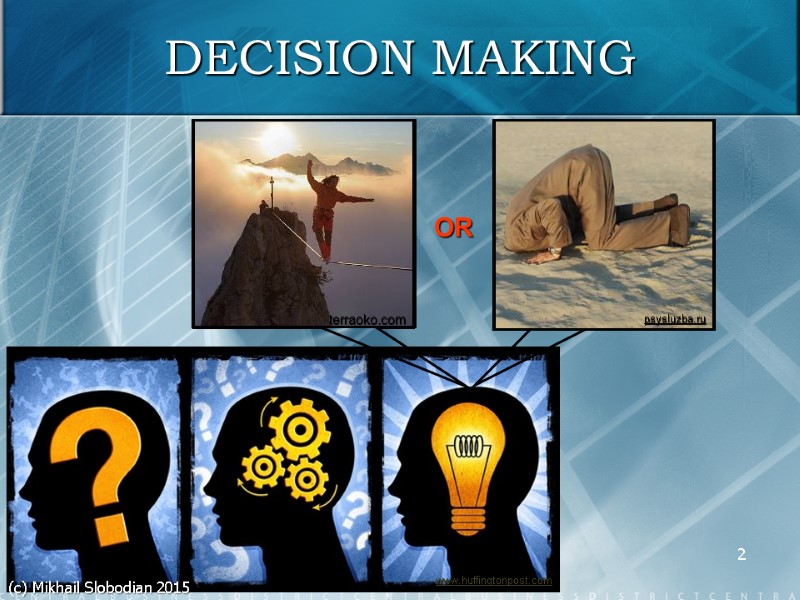
2 DECISION MAKING OR www.huffingtonpost.com terraoko.com psysluzba.ru (c) Mikhail Slobodian 2015
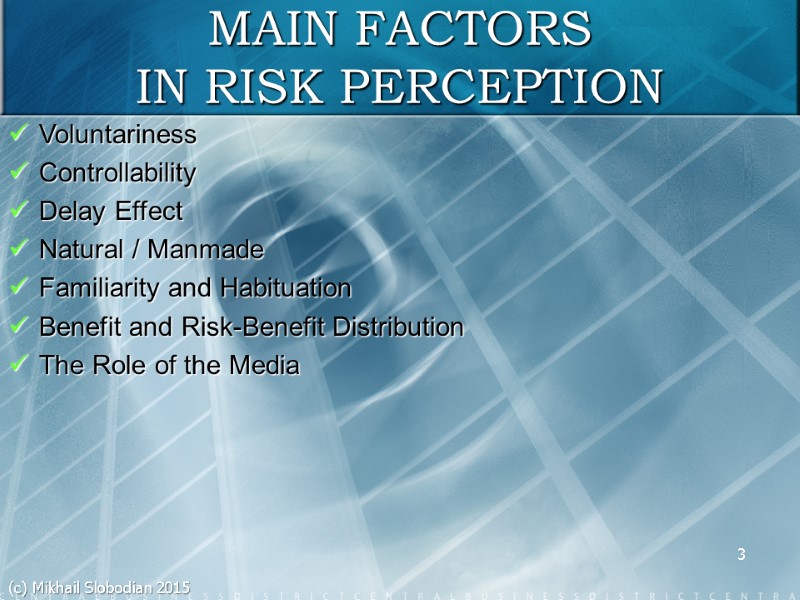
3 MAIN FACTORS IN RISK PERCEPTION Voluntariness Controllability Delay Effect Natural / Manmade Familiarity and Habituation Benefit and Risk-Benefit Distribution The Role of the Media (c) Mikhail Slobodian 2015
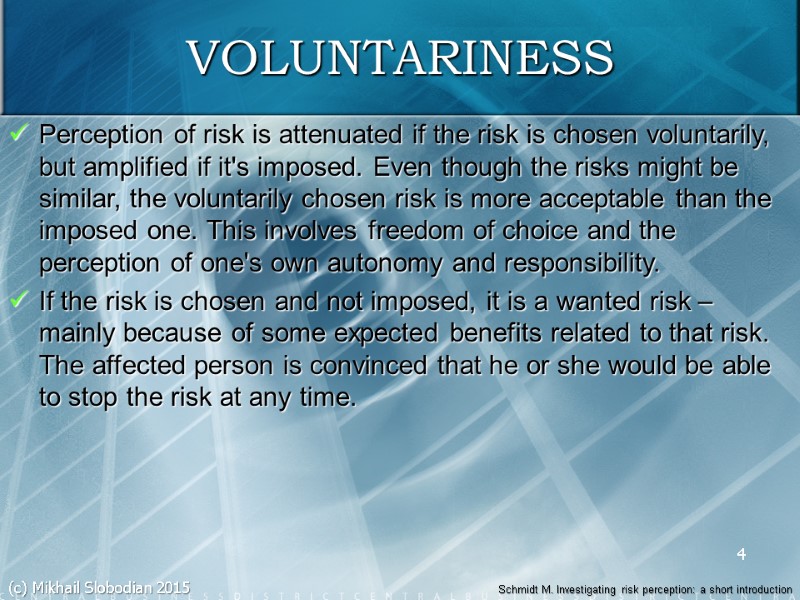
4 VOLUNTARINESS Perception of risk is attenuated if the risk is chosen voluntarily, but amplified if it's imposed. Even though the risks might be similar, the voluntarily chosen risk is more acceptable than the imposed one. This involves freedom of choice and the perception of one's own autonomy and responsibility. If the risk is chosen and not imposed, it is a wanted risk – mainly because of some expected benefits related to that risk. The affected person is convinced that he or she would be able to stop the risk at any time. (c) Mikhail Slobodian 2015 Schmidt M. Investigating risk perception: a short introduction
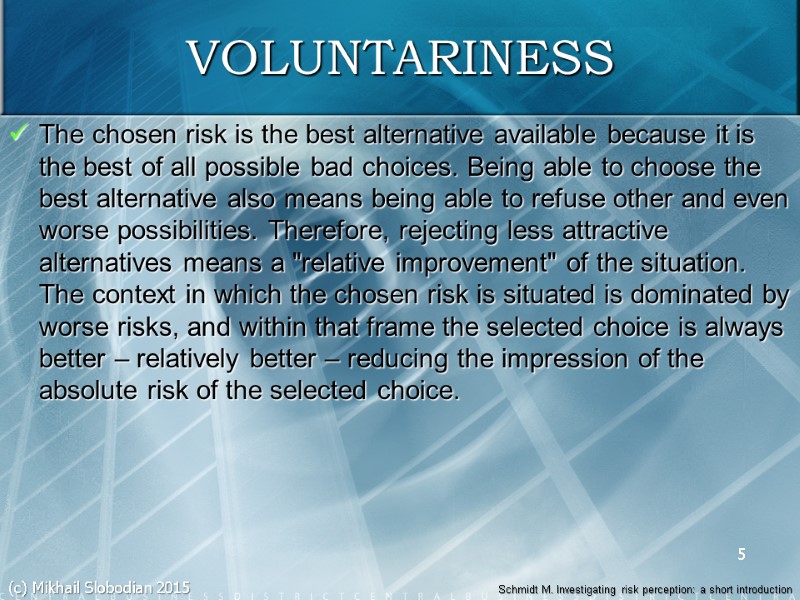
5 VOLUNTARINESS The chosen risk is the best alternative available because it is the best of all possible bad choices. Being able to choose the best alternative also means being able to refuse other and even worse possibilities. Therefore, rejecting less attractive alternatives means a "relative improvement" of the situation. The context in which the chosen risk is situated is dominated by worse risks, and within that frame the selected choice is always better – relatively better – reducing the impression of the absolute risk of the selected choice. (c) Mikhail Slobodian 2015 Schmidt M. Investigating risk perception: a short introduction
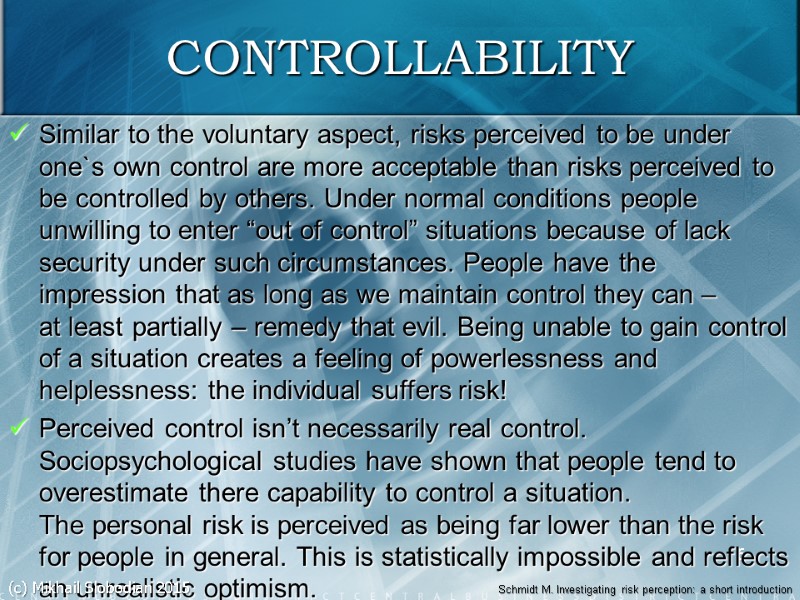
6 CONTROLLABILITY Similar to the voluntary aspect, risks perceived to be under one`s own control are more acceptable than risks perceived to be controlled by others. Under normal conditions people unwilling to enter “out of control” situations because of lack security under such circumstances. People have the impression that as long as we maintain control they can – at least partially – remedy that evil. Being unable to gain control of a situation creates a feeling of powerlessness and helplessness: the individual suffers risk! Perceived control isn’t necessarily real control. Sociopsychological studies have shown that people tend to overestimate there capability to control a situation. The personal risk is perceived as being far lower than the risk for people in general. This is statistically impossible and reflects an unrealistic optimism. (c) Mikhail Slobodian 2015 Schmidt M. Investigating risk perception: a short introduction
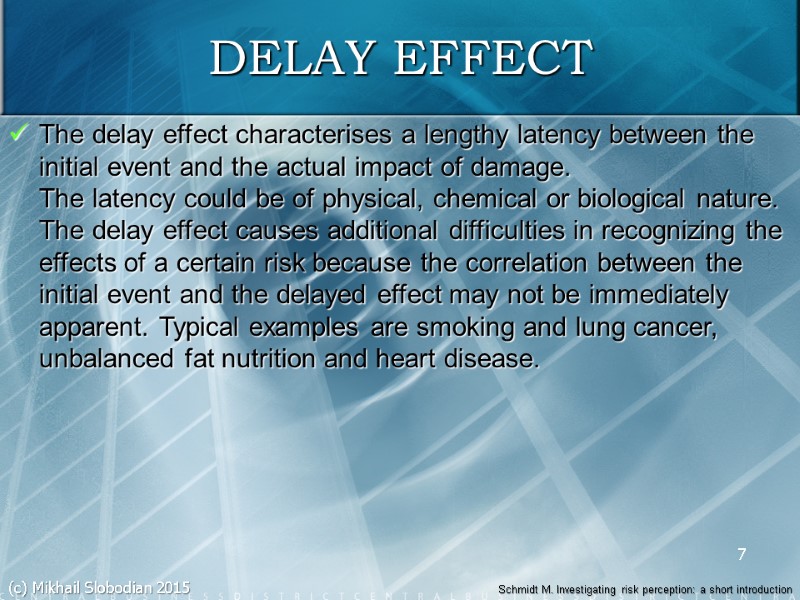
7 DELAY EFFECT The delay effect characterises a lengthy latency between the initial event and the actual impact of damage. The latency could be of physical, chemical or biological nature. The delay effect causes additional difficulties in recognizing the effects of a certain risk because the correlation between the initial event and the delayed effect may not be immediately apparent. Typical examples are smoking and lung cancer, unbalanced fat nutrition and heart disease. (c) Mikhail Slobodian 2015 Schmidt M. Investigating risk perception: a short introduction
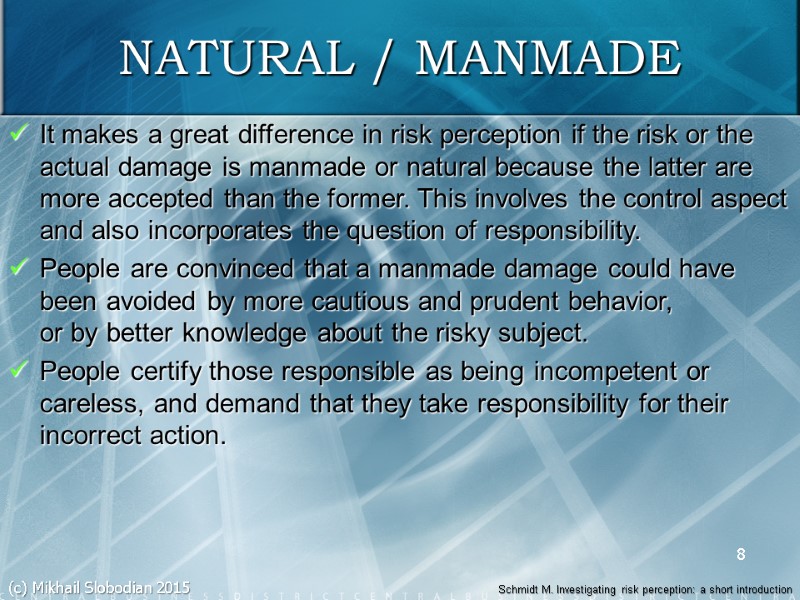
8 NATURAL / MANMADE It makes a great difference in risk perception if the risk or the actual damage is manmade or natural because the latter are more accepted than the former. This involves the control aspect and also incorporates the question of responsibility. People are convinced that a manmade damage could have been avoided by more cautious and prudent behavior, or by better knowledge about the risky subject. People certify those responsible as being incompetent or careless, and demand that they take responsibility for their incorrect action. (c) Mikhail Slobodian 2015 Schmidt M. Investigating risk perception: a short introduction
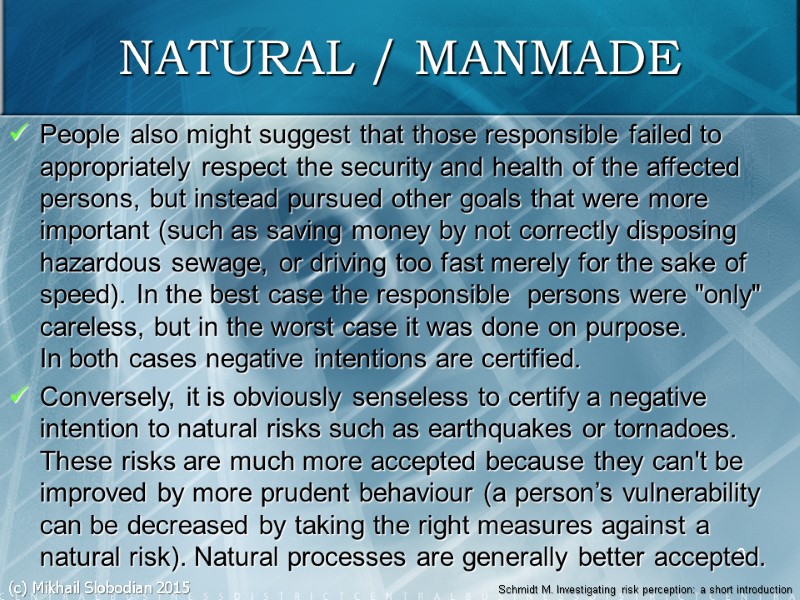
9 NATURAL / MANMADE People also might suggest that those responsible failed to appropriately respect the security and health of the affected persons, but instead pursued other goals that were more important (such as saving money by not correctly disposing hazardous sewage, or driving too fast merely for the sake of speed). In the best case the responsible persons were "only" careless, but in the worst case it was done on purpose. In both cases negative intentions are certified. Conversely, it is obviously senseless to certify a negative intention to natural risks such as earthquakes or tornadoes. These risks are much more accepted because they can't be improved by more prudent behaviour (a person’s vulnerability can be decreased by taking the right measures against a natural risk). Natural processes are generally better accepted. (c) Mikhail Slobodian 2015 Schmidt M. Investigating risk perception: a short introduction
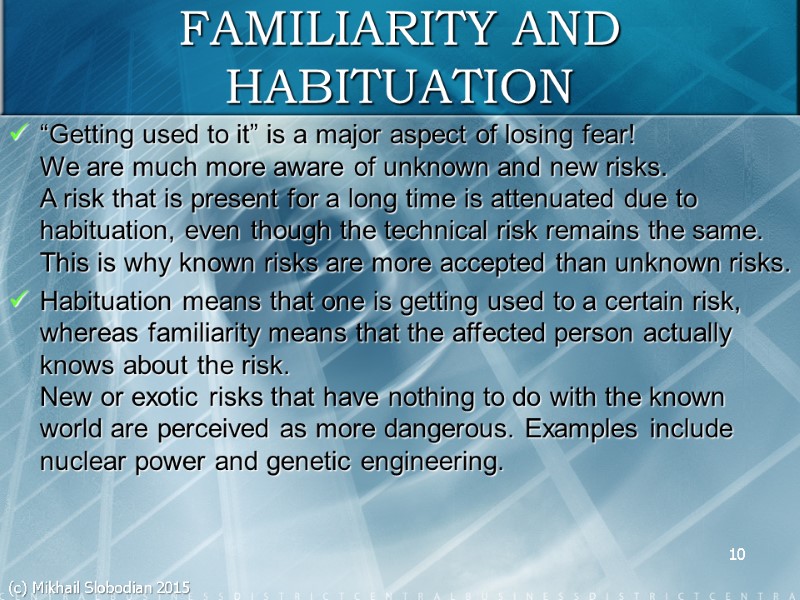
10 FAMILIARITY AND HABITUATION “Getting used to it” is a major aspect of losing fear! We are much more aware of unknown and new risks. A risk that is present for a long time is attenuated due to habituation, even though the technical risk remains the same. This is why known risks are more accepted than unknown risks. Habituation means that one is getting used to a certain risk, whereas familiarity means that the affected person actually knows about the risk. New or exotic risks that have nothing to do with the known world are perceived as more dangerous. Examples include nuclear power and genetic engineering. (c) Mikhail Slobodian 2015
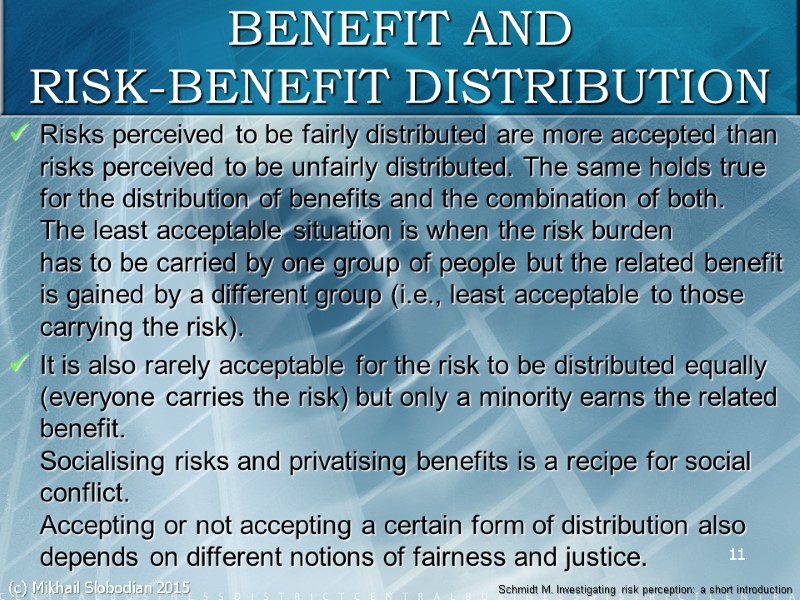
11 BENEFIT AND RISK-BENEFIT DISTRIBUTION Risks perceived to be fairly distributed are more accepted than risks perceived to be unfairly distributed. The same holds true for the distribution of benefits and the combination of both. The least acceptable situation is when the risk burden has to be carried by one group of people but the related benefit is gained by a different group (i.e., least acceptable to those carrying the risk). It is also rarely acceptable for the risk to be distributed equally (everyone carries the risk) but only a minority earns the related benefit. Socialising risks and privatising benefits is a recipe for social conflict. Accepting or not accepting a certain form of distribution also depends on different notions of fairness and justice. (c) Mikhail Slobodian 2015 Schmidt M. Investigating risk perception: a short introduction
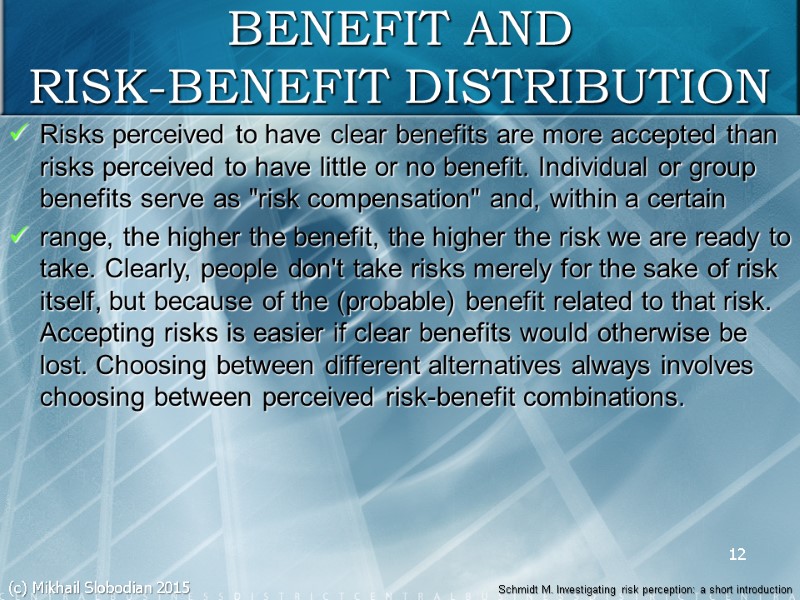
12 BENEFIT AND RISK-BENEFIT DISTRIBUTION Risks perceived to have clear benefits are more accepted than risks perceived to have little or no benefit. Individual or group benefits serve as "risk compensation" and, within a certain range, the higher the benefit, the higher the risk we are ready to take. Clearly, people don't take risks merely for the sake of risk itself, but because of the (probable) benefit related to that risk. Accepting risks is easier if clear benefits would otherwise be lost. Choosing between different alternatives always involves choosing between perceived risk-benefit combinations. (c) Mikhail Slobodian 2015 Schmidt M. Investigating risk perception: a short introduction
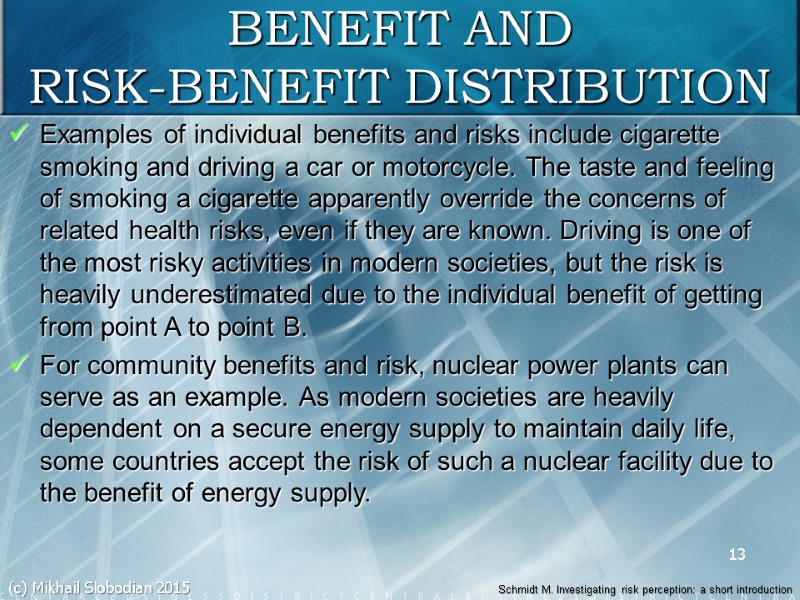
13 BENEFIT AND RISK-BENEFIT DISTRIBUTION Examples of individual benefits and risks include cigarette smoking and driving a car or motorcycle. The taste and feeling of smoking a cigarette apparently override the concerns of related health risks, even if they are known. Driving is one of the most risky activities in modern societies, but the risk is heavily underestimated due to the individual benefit of getting from point A to point B. For community benefits and risk, nuclear power plants can serve as an example. As modern societies are heavily dependent on a secure energy supply to maintain daily life, some countries accept the risk of such a nuclear facility due to the benefit of energy supply. (c) Mikhail Slobodian 2015 Schmidt M. Investigating risk perception: a short introduction
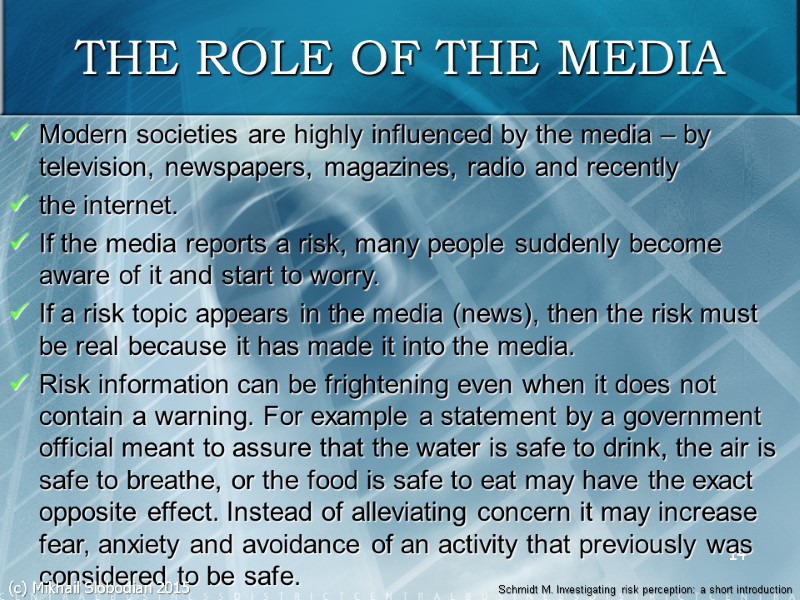
14 THE ROLE OF THE MEDIA Modern societies are highly influenced by the media – by television, newspapers, magazines, radio and recently the internet. If the media reports a risk, many people suddenly become aware of it and start to worry. If a risk topic appears in the media (news), then the risk must be real because it has made it into the media. Risk information can be frightening even when it does not contain a warning. For example a statement by a government official meant to assure that the water is safe to drink, the air is safe to breathe, or the food is safe to eat may have the exact opposite effect. Instead of alleviating concern it may increase fear, anxiety and avoidance of an activity that previously was considered to be safe. (c) Mikhail Slobodian 2015 Schmidt M. Investigating risk perception: a short introduction
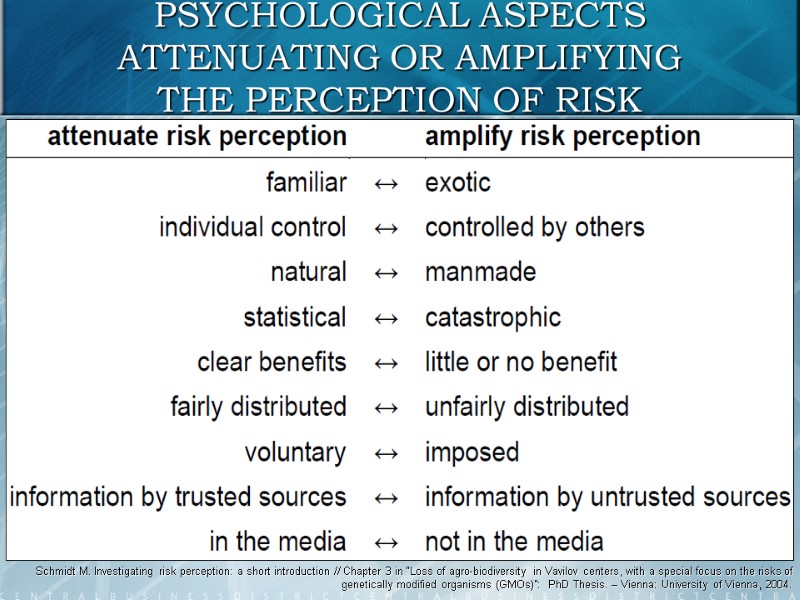
15 PSYCHOLOGICAL ASPECTS ATTENUATING OR AMPLIFYING THE PERCEPTION OF RISK Schmidt M. Investigating risk perception: a short introduction // Chapter 3 in “Loss of agro-biodiversity in Vavilov centers, with a special focus on the risks of genetically modified organisms (GMOs)”: PhD Thesis. – Vienna: University of Vienna, 2004.
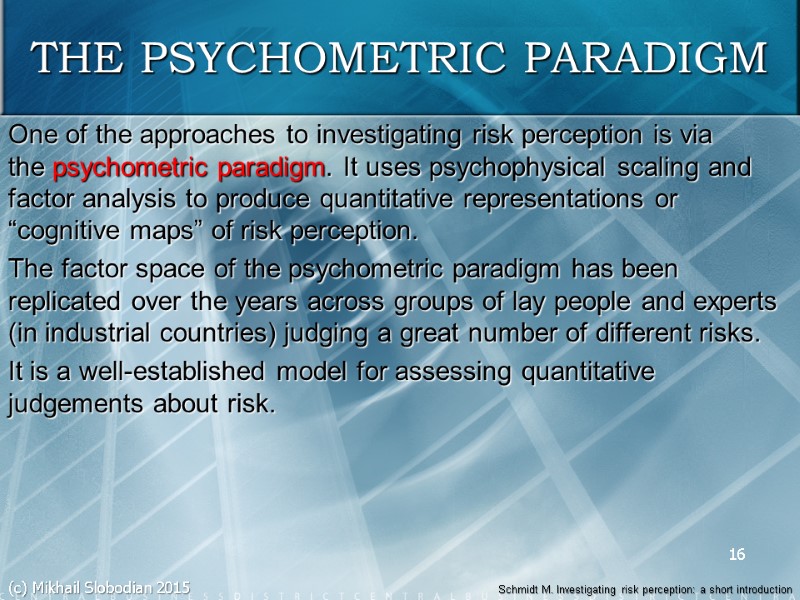
16 THE PSYCHOMETRIC PARADIGM One of the approaches to investigating risk perception is via the psychometric paradigm. It uses psychophysical scaling and factor analysis to produce quantitative representations or “cognitive maps” of risk perception. The factor space of the psychometric paradigm has been replicated over the years across groups of lay people and experts (in industrial countries) judging a great number of different risks. It is a well-established model for assessing quantitative judgements about risk. (c) Mikhail Slobodian 2015 Schmidt M. Investigating risk perception: a short introduction
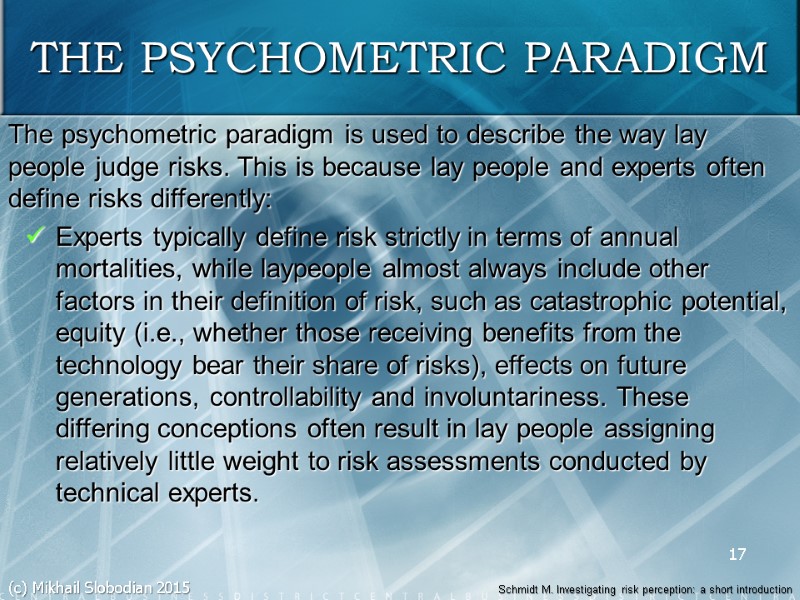
17 THE PSYCHOMETRIC PARADIGM The psychometric paradigm is used to describe the way lay people judge risks. This is because lay people and experts often define risks differently: Experts typically define risk strictly in terms of annual mortalities, while laypeople almost always include other factors in their definition of risk, such as catastrophic potential, equity (i.e., whether those receiving benefits from the technology bear their share of risks), effects on future generations, controllability and involuntariness. These differing conceptions often result in lay people assigning relatively little weight to risk assessments conducted by technical experts. (c) Mikhail Slobodian 2015 Schmidt M. Investigating risk perception: a short introduction
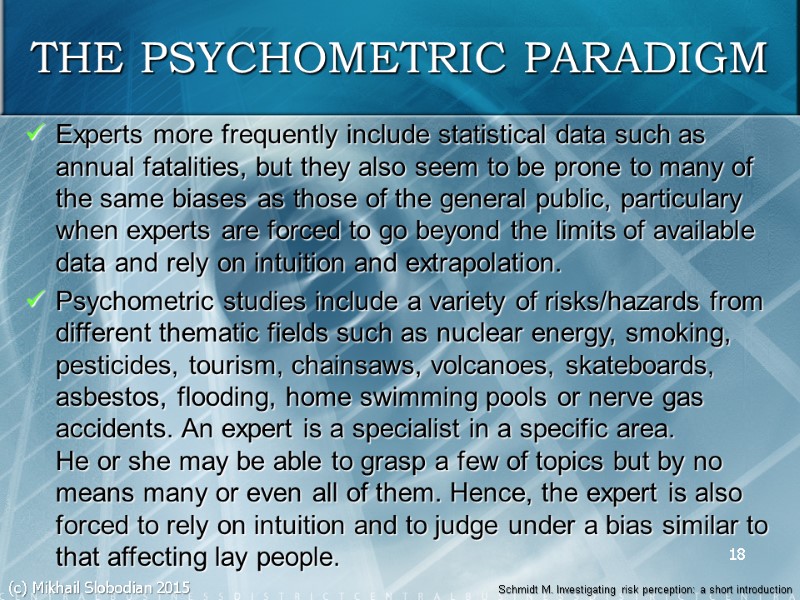
18 THE PSYCHOMETRIC PARADIGM Experts more frequently include statistical data such as annual fatalities, but they also seem to be prone to many of the same biases as those of the general public, particulary when experts are forced to go beyond the limits of available data and rely on intuition and extrapolation. Psychometric studies include a variety of risks/hazards from different thematic fields such as nuclear energy, smoking, pesticides, tourism, chainsaws, volcanoes, skateboards, asbestos, flooding, home swimming pools or nerve gas accidents. An expert is a specialist in a specific area. He or she may be able to grasp a few of topics but by no means many or even all of them. Hence, the expert is also forced to rely on intuition and to judge under a bias similar to that affecting lay people. (c) Mikhail Slobodian 2015 Schmidt M. Investigating risk perception: a short introduction
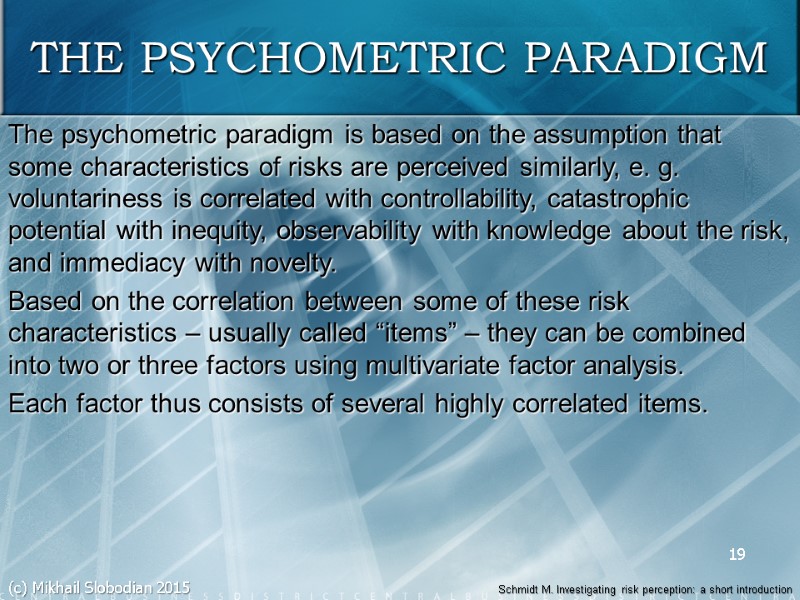
19 THE PSYCHOMETRIC PARADIGM The psychometric paradigm is based on the assumption that some characteristics of risks are perceived similarly, e. g. voluntariness is correlated with controllability, catastrophic potential with inequity, observability with knowledge about the risk, and immediacy with novelty. Based on the correlation between some of these risk characteristics – usually called “items” – they can be combined into two or three factors using multivariate factor analysis. Each factor thus consists of several highly correlated items. (c) Mikhail Slobodian 2015 Schmidt M. Investigating risk perception: a short introduction
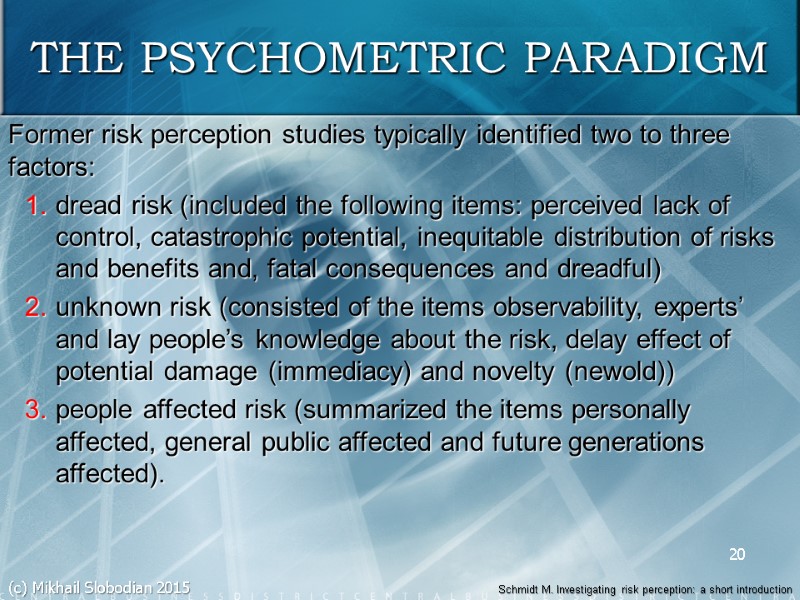
20 THE PSYCHOMETRIC PARADIGM Former risk perception studies typically identified two to three factors: dread risk (included the following items: perceived lack of control, catastrophic potential, inequitable distribution of risks and benefits and, fatal consequences and dreadful) unknown risk (consisted of the items observability, experts’ and lay people’s knowledge about the risk, delay effect of potential damage (immediacy) and novelty (newold)) people affected risk (summarized the items personally affected, general public affected and future generations affected). (c) Mikhail Slobodian 2015 Schmidt M. Investigating risk perception: a short introduction
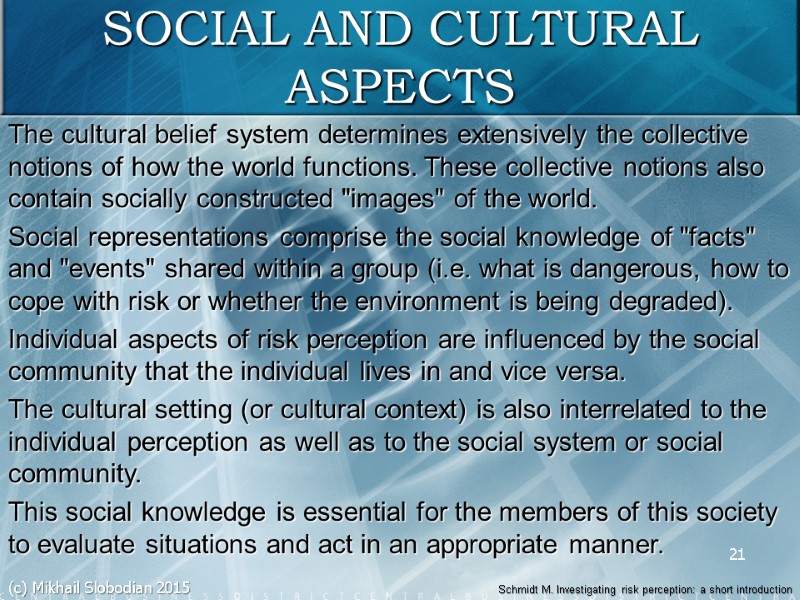
21 SOCIAL AND CULTURAL ASPECTS The cultural belief system determines extensively the collective notions of how the world functions. These collective notions also contain socially constructed "images" of the world. Social representations comprise the social knowledge of "facts" and "events" shared within a group (i.e. what is dangerous, how to cope with risk or whether the environment is being degraded). Individual aspects of risk perception are influenced by the social community that the individual lives in and vice versa. The cultural setting (or cultural context) is also interrelated to the individual perception as well as to the social system or social community. This social knowledge is essential for the members of this society to evaluate situations and act in an appropriate manner. (c) Mikhail Slobodian 2015 Schmidt M. Investigating risk perception: a short introduction
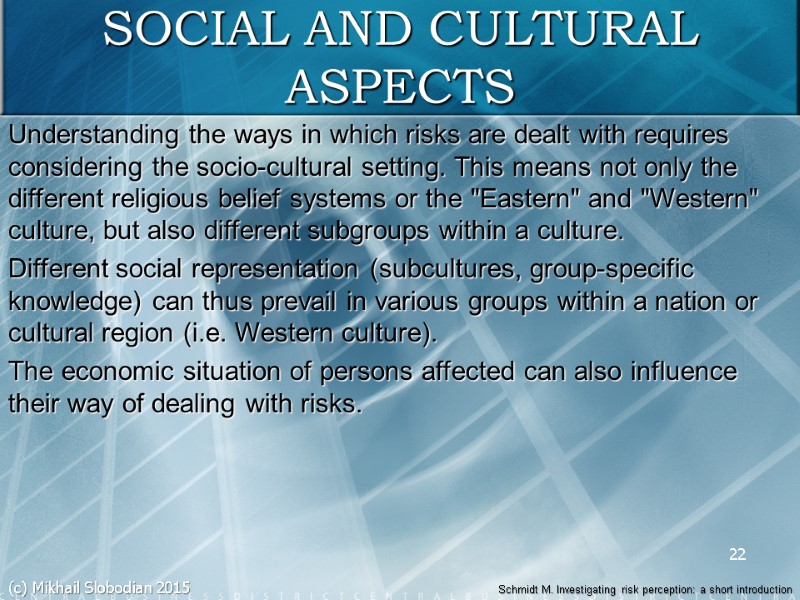
22 SOCIAL AND CULTURAL ASPECTS Understanding the ways in which risks are dealt with requires considering the socio-cultural setting. This means not only the different religious belief systems or the "Eastern" and "Western" culture, but also different subgroups within a culture. Different social representation (subcultures, group-specific knowledge) can thus prevail in various groups within a nation or cultural region (i.e. Western culture). The economic situation of persons affected can also influence their way of dealing with risks. (c) Mikhail Slobodian 2015 Schmidt M. Investigating risk perception: a short introduction
1088-02_-_perception_of_risk.ppt
- Количество слайдов: 22

